Top Rankings
Oregon City School District ranks among the top 20% of public school district in Ohio for:
Category
Attribute
Community Size
Largest student body (number of students) (Top 1%)
For the 2025 school year, there are 6 public schools serving 3,292 students in Oregon City School District. This district's average testing ranking is 6/10, which is in the top 50% of public schools in Ohio.
Public Schools in Oregon City School District have an average math proficiency score of 54% (versus the Ohio public school average of 52%), and reading proficiency score of 61% (versus the 60% statewide average).
Minority enrollment is 22% of the student body (majority Hispanic), which is less than the Ohio public school average of 34% (majority Black).
Overview
This School District
This State (OH)
# Schools
6 Schools
3,572 Schools
# Students
3,292 Students
1,670,552 Students
# Teachers
207 Teachers
96,800 Teachers
Student : Teacher Ratio
16:1
16:1
District Rank
Oregon City School District, which is ranked within the top 50% of all 918 school districts in Ohio (based off of combined math and reading proficiency testing data) for the 2021-2022 school year.
The school district's graduation rate of 95% has decreased from 96% over five school years.
Overall District Rank
#391 out of 929 school districts
(Top 50%)
(Top 50%)

Math Test Scores (% Proficient)
54%
52%
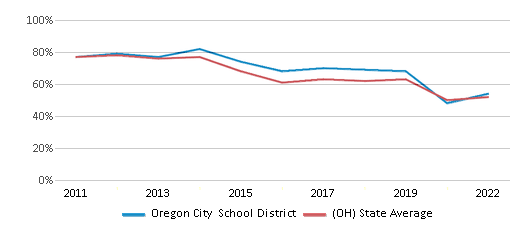
Reading/Language Arts Test Scores (% Proficient)
61%
60%

Science Test Scores (% Proficient)
69%
63%

Graduation Rate
95%
86%
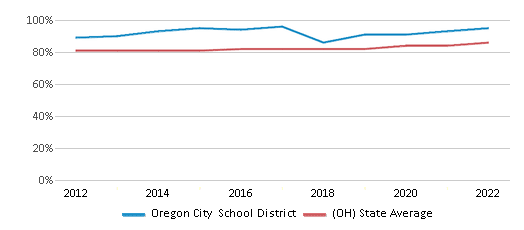
Students by Ethnicity:
Diversity Score
0.37
0.53
# American Indian Students
6 Students
2,370 Students
% American Indian Students
n/a
n/a
# Asian Students
24 Students
49,192 Students
% Asian Students
1%
3%
# Hispanic Students
543 Students
130,270 Students
% Hispanic Students
17%
8%
# Black Students
112 Students
283,872 Students
% Black Students
3%
17%
# White Students
2,559 Students
1,098,036 Students
% White Students
78%
66%
# Hawaiian Students
1 Student
1,718 Students
% Hawaiian Students
n/a
n/a
# Two or more races Students
47 Students
105,080 Students
% of Two or more races Students
1%
6%
Students by Grade:
# Students in PK Grade:
-
46,438
# Students in K Grade:
249
117,523
# Students in 1st Grade:
231
119,240
# Students in 2nd Grade:
249
123,668
# Students in 3rd Grade:
249
116,979
# Students in 4th Grade:
255
120,578
# Students in 5th Grade:
232
121,564
# Students in 6th Grade:
222
121,429
# Students in 7th Grade:
242
123,631
# Students in 8th Grade:
255
124,479
# Students in 9th Grade:
290
136,464
# Students in 10th Grade:
286
133,227
# Students in 11th Grade:
275
135,708
# Students in 12th Grade:
257
129,624
# Ungraded Students:
-
-
District Revenue and Spending
The revenue/student of $16,579 in this school district is less than the state median of $17,287. The school district revenue/student has stayed relatively flat over four school years.
The school district's spending/student of $15,395 is less than the state median of $17,235. The school district spending/student has stayed relatively flat over four school years.
Total Revenue
$55 MM
$28,879 MM
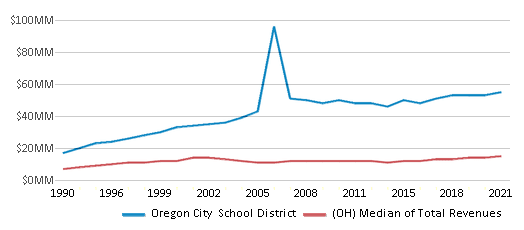
Spending
$51 MM
$28,792 MM
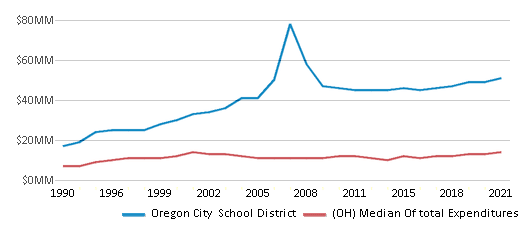
Revenue / Student
$16,579
$17,287
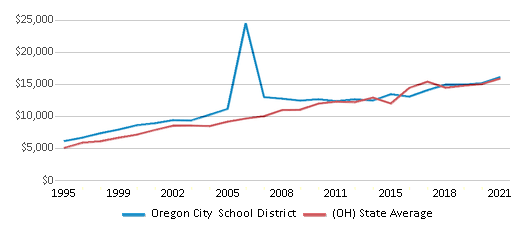
Spending / Student
$15,395
$17,235
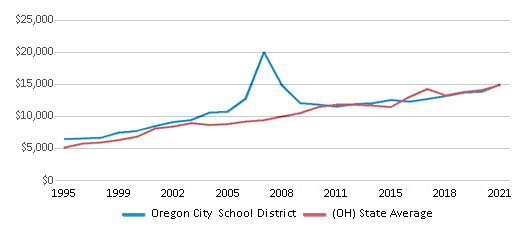
Best Oregon City School District Public Schools (2025)
School
(Math and Reading Proficiency)
(Math and Reading Proficiency)
Location
Grades
Students
Rank: #11.
Jerusalem Elementary School
(Math: 70-74% | Reading: 70-74%)
Rank:
Rank:
8/
Top 30%10
535 S Yondota Rd
Curtice, OH 43412
(419) 836-6111
Curtice, OH 43412
(419) 836-6111
Grades: K-4
| 442 students
Rank: #22.
Coy Elementary School
(Math: 65-69% | Reading: 65-69%)
Rank:
Rank:
7/
Top 50%10
3604 Pickle Rd
Oregon, OH 43616
(419) 693-0624
Oregon, OH 43616
(419) 693-0624
Grades: K-4
| 334 students
Rank: #33.
Eisenhower Intermediate School
(Math: 65% | Reading: 68%)
Rank:
Rank:
7/
Top 50%10
331 North Curtice Road
Oregon, OH 43616
(419) 836-8498
Oregon, OH 43616
(419) 836-8498
Grades: 5-6
| 454 students
Rank: #44.
Starr Elementary School
(Math: 60-64% | Reading: 60-64%)
Rank:
Rank:
6/
Top 50%10
3230 Starr Ave
Oregon, OH 43616
(419) 693-0589
Oregon, OH 43616
(419) 693-0589
Grades: K-4
| 457 students
Rank: #55.
Clay High School
(Math: 38% | Reading: 60%)
Rank:
Rank:
4/
Bottom 50%10
5665 Seaman St
Oregon, OH 43616
(419) 693-0665
Oregon, OH 43616
(419) 693-0665
Grades: 9-12
| 1,108 students
Rank: #66.
Fassett Junior High School
(Math: 41% | Reading: 52%)
Rank:
Rank:
4/
Bottom 50%10
3025 Starr Ave
Oregon, OH 43616
(419) 693-0455
Oregon, OH 43616
(419) 693-0455
Grades: 7-8
| 497 students
Frequently Asked Questions
How many schools belong to Oregon City School District?
Oregon City School District manages 6 public schools serving 3,292 students.
What is the rank of Oregon City School District?
Oregon City School District is ranked #394 out of 918 school districts in Ohio (top 50%) based off of combined math and reading proficiency testing data for the 2021-2022 school year. This district ranks in the top 20% of Ohio school districts for: Largest student body (number of students) (Top 1%)
What is the racial composition of students in Oregon City School District?
78% of Oregon City School District students are White, 17% of students are Hispanic, 3% of students are Black, 1% of students are Asian, and 1% of students are Two or more races.
What is the student/teacher ratio of Oregon City School District?
Oregon City School District has a student/teacher ratio of 16:1, which is lower than the Ohio state average of 17:1.
What is Oregon City School District's spending/student ratio?
The school district's spending/student of $15,395 is less than the state median of $17,235. The school district spending/student has stayed relatively flat over four school years.
Recent Articles

Year-Round Or Traditional Schedule?
Which is more appropriate for your child? A year-round attendance schedule or traditional schedule? We look at the pros and cons.

Why You Should Encourage Your Child to Join a Sports Team
Participating in team sports has a great many benefits for children, there is no doubt. In this article you will learn what those benefits are.

White Students are Now the Minority in U.S. Public Schools
Increasing birth rates among immigrant families from Asia and Central and South America, combined with lower birth rates among white families, means that for the first time in history, public school students in the United States are majority-minority. This shift in demographics poses difficulties for schools as they work to accommodate children of varying language abilities and socio-economic backgrounds.





